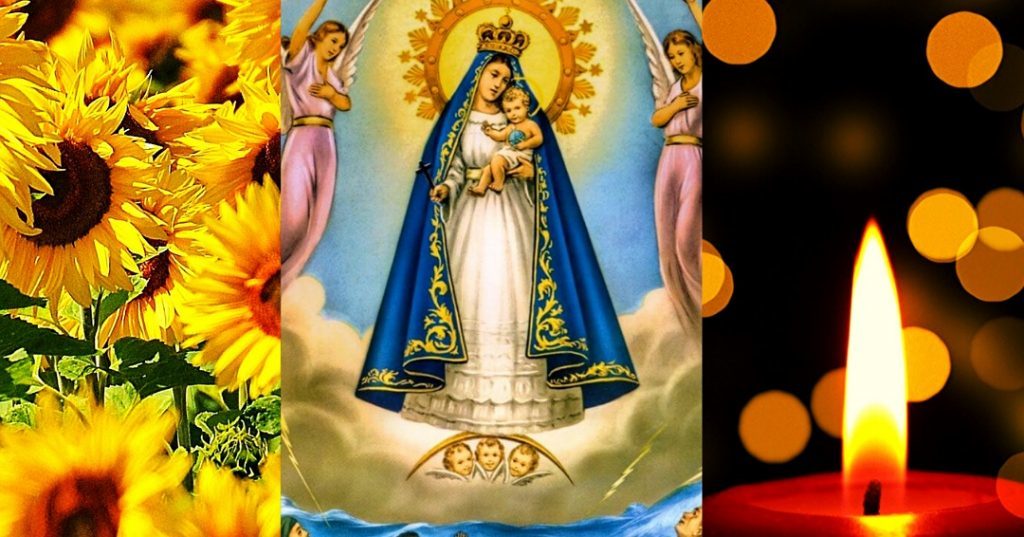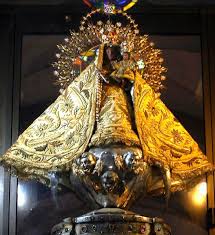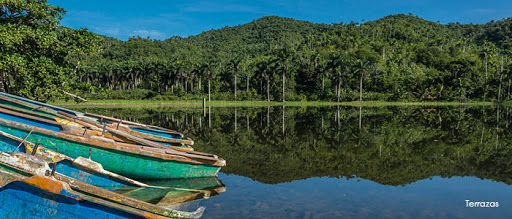
LA VIRGEN DE LA CARIDAD DEL COBRE, NUESTRA AMADA “CACHITA”.
Nuestra Señora de la Caridad del Cobre, o la Virgen de la Caridad del Cobre, Caridad del Cobre o simplemente Cachita, es una de las advocaciones de la Virgen María.
Una fiesta venerada a una deidad del color cubano, surgida como imagen del mar por humildes pescadores, es amada cada 8 de septiembre.
En Cuba, nación antillana, la Virgen de la Caridad con su color de cobre transita en cada hogar bajo un festejo único que celebran los católicos y los creyentes de religiones de origen africanos.
La fecha motiva la asistencia o peregrinación de sus devotos, quienes a lo largo del país acuden, en especial este día, a rendirle homenaje en templos y altares o pidiendo sus favores y bendiciones. De igual manera la religiosidad del pueblo se manifiesta en muchos hogares en donde podemos encontrar cuadros e imágenes de la virgencita con el Niño Jesús en los brazos y una cruz.
Nuestra Señora de la Caridad del Cobre, la Virgen de la Caridad del Cobre, Caridad del Cobre, Oshun o simplemente Cachita, como algunos la conocen es la Patrona de los cubanos. Así, en solemne nombramiento fue proclamada por el Papa Benedicto XV en el año 1916. Y en reconocimiento al pueblo, durante su visita a la Isla el 4 de enero de 1998, el Papa Juan Pablo II coronó y bendijo la imagen de la Patrona de Cuba durante la tercera misa que ofició en nuestro país, celebrada en la Plaza Antonio Maceo de la ciudad de Santiago de Cuba, el 24 de enero de 1998.
También, es conocida como “La Mambisa” su bella imagen es custodiada en la Parroquia de Santo Tomas en la Arquidiócesis de Santiago de Cuba, llamada así por estar vinculada a la historia patria, pues durante las Guerras de Independencia de Cuba iniciadas en 1868 la devoción por la Virgen de la Caridad acompañó a las tropas del Ejército Libertador en los campos de guerra contra la colonia española.
SE AVIVA LA LLEGADA DE LA VIRGEN
La leyenda que acompaña la llegada de la Virgen a Cuba dice que en 1613 dos hermanos descendientes de indígenas, Juan y Rodrigo de Hoyos, y un negrito de nueve o 10 años, llamado Juan Moreno, buscaban sal en la bahía de Nipe, la mayor de Cuba, situada en el extremo este de la oriental villa de Santiago de Cuba, cuando avistaron la imagen, flotando en el mar con una tablilla donde podía leerse la frase “Yo soy la Virgen de la Caridad del Cobre”.
Más tarde, ante la preocupación por las continuas desapariciones de la Virgen, esta fue trasladada al Hato de Barajagua en donde se encontraban las autoridades de aquel lugar; su segunda estación sería el poblado Real de Minas -en las minas de Santiago del Prado muy cerca de la villa de Santiago de Cuba, donde se abre una de las mayores vetas de cobre a cielo abierto de América- para ser llevada luego, en el año 1648, a una nueva ermita construida en lo alto de la serranía de las minas. Los vecinos recibieron el hallazgo como una buena señal del cielo y construyeron de inmediato la ermita para que sirviera de templo a la imagen y al borde de la mina, los mineros levantaron el primer santuario, en el mismo sitio donde hoy se encuentra la iglesia.
La Basílica Santuario Nacional de Nuestra Señora de la Caridad del Cobre, donde cada mañana se oficia una misa, conserva la imagen original de la virgen, con su capa de oro -que puede verse desde todos los ángulos del templo- constituye uno de los sitios más religiosos y venerados por el pueblo cubano. Está ubicada en lo más alto del Cerro de Maboa, a 27 kilómetros de la oriental ciudad de Santiago de Cuba.
El primer santuario del Cobre en 1906 se desplomó producto a las explosiones y excavaciones de las minas y es proclamado como Basílica el 22 de diciembre de 1907 por el Papa Pablo VI. A la construcción actual, inaugurada el 8 de septiembre de 1927, se accede a través de una escalinata que tiene tres grupos de escalones flanqueados por una muralla baja que tiene faroles que de noche permanecen encendidos. Posee naves rematadas por torres donde se enseñorean campanarios en un nivel más bajo, con una fachada principal simétrica y su estructura central concluye en una cúpula.
La iglesia, está decorada en tonos ocre y blanco y la virgen que está guardada en el interior de estos muros es de oro y se alza en un altar móvil que puede verse desde todos los rincones de la nave principal, este altar es de mármol y plata maciza y está decorado con objetos de enorme valor.
Debajo del Camarín de la Virgen está la denominada Capilla de los Milagros, un pequeño recinto donde los creyentes y no creyentes ,nacionales o extranjeros, que visitan el sitio depositan disímiles ofrendas personales: joyas de oro y piedras preciosas, cadenas, vestuarios, medallas olímpicas, ropitas de bebé, muchos objetos comunes pero que entrañan una riqueza para los fieles. Otros retornan a sus hogares con diminutas piedras donde brilla el cobre de la mina, llevándolas como especial protección para la salud y contra los males o guardianes de un futuro mejor.
El 26 de marzo de 2012 el Papa Benedicto XVI le otorga la Rosa de Oro de la Cristiandad, con motivo del cuadringentésimo aniversario de la aparición de la imagen y el Papa Francisco, en su vista a la Isla, en septiembre de 2015, y con motivo la conmemoración de los 100 de la consagración de Cuba decretó el Año Santo Excepcional de la Misericordia.
La imagen de la Virgen de la Caridad ha salido de su santuario sólo en cuatro ocasiones:
– 1936 cuando fue coronada por el Arzobispo de Santiago de Cuba.
– 1952 en el Cincuentenario de la República.
– 1959 asiste al Congreso Nacional Católico en La Habana.
– 1998 es coronada por el Papa Juan Pablo II en la plaza Antonio Maceo.
2011 – 2012 – Recorrido por todo el país en celebración de los 400 años de la aparición de la virgen.
Este próximo Septiembre 8, será otro nuevo Dia de la Caridad para todos los cubanos, en cualquier latitud que se halle, se le rinde homenaje a la Patrona con devoción y espiritualidad.
 THE VIRGIN OF THE CHARITY OF EL COBRE, OUR BELOVED “CACHITA”.
THE VIRGIN OF THE CHARITY OF EL COBRE, OUR BELOVED “CACHITA”.
Our Lady of Caridad del Cobre, or the Virgin of la Caridad del Cobre, Caridad del Cobre or simply Cachita, is one of the invocations of the Virgin Mary.
A festival worshiped to a deity of Cuban color, emerged as an image of the sea by humble fishermen, is loved every September 8.
In Cuba, an Antillean nation, the Virgin of Charity with its copper color passes through each home under a unique celebration that is celebrated by Catholics and believers of religions of African origin.
The date motivates the attendance or pilgrimage of her devotees, who throughout the country come, especially on this day, to pay homage to her in temples and altars or asking for her favors and blessings. In the same way, the religiosity of the town is manifested in many homes where we can find pictures and images of the Virgin with the Child Jesus in her arms and across.
Our Lady of Caridad del Cobre, the Virgin of Caridad del Cobre, Caridad del Cobre, Oshun, or simply Cachita, as some know her is the Patroness of Cubans. Thus, in the solemn appointment, it was proclaimed by Pope Benedict XV in 1916. And in recognition of the people, during his visit to the Island on January 4, 1998, Pope John Paul II crowned and blessed the image of the Patron Saint of Cuba during the third mass he officiated in our country, held in the Plaza Antonio Maceo in the city of Santiago de Cuba, on January 24, 1998.
Also, it is known as “La Mambisa” its beautiful image is guarded in the Santo Tomas Parish in the Archdiocese of Santiago de Cuba, so-called because it is linked to the country’s history because during the Cuban Wars of Independence that began in 1868 the Devotion to the Virgin of Charity accompanied the troops of the Liberation Army in the fields of war against the Spanish colony.
THE ARRIVAL OF THE VIRGIN IS REVIVED
The legend that accompanies the arrival of the Virgin to Cuba says that in 1613 two brothers descended from indigenous people, Juan and Rodrigo de Hoyos, and a nine or a 10-year-old black boy named Juan Moreno, were looking for salt in the Nipe Bay, the largest de Cuba, located at the eastern end of the eastern town of Santiago de Cuba, when they sighted the image, floating in the sea with a tablet where you could read the phrase “I am the Virgin of Charity of Copper.”
Later, due to the concern for the continuous disappearances of the Virgin, she was transferred to the Hato de Barajagua where the authorities of that place were located; Its second station would be the town of Real de Minas -in the mines of Santiago del Prado very close to the town of Santiago de Cuba, where one of the largest open-cast copper veins in America opens- to be taken later, in the year 1648, to a new hermitage built at the top of the mountain range of mines. The neighbors received the finding as a good sign from heaven and immediately built the hermitage to serve as a temple to the image and on the edge of the mine, the miners built the first sanctuary, in the same place where the church is today.
The National Sanctuary Basilica of Nuestra Señora de la Caridad del Cobre, where a mass is celebrated every morning, preserves the original image of the Virgin, with her gold cape -which can be seen from all angles of the temple- constitutes one of the sites more religious and revered by the Cuban people. It is located at the top of Cerro de Maboa, 27 kilometers from the eastern city of Santiago de Cuba.
The first shrine of El Cobre in 1906 collapsed due to the explosions and excavations of the mines and is proclaimed as a Basilica on December 22, 1907, by Pope Paul VI. The current construction, inaugurated on September 8, 1927, is accessed through a staircase that has three groups of steps flanked by a low wall that has lanterns that remain lit at night. It has naves topped by towers where bell towers dominate on a lower level, with a symmetrical main façade and its central structure ends in a dome.
The church is decorated in ocher and white tones and the virgin that is kept inside these walls is made of gold and stands on a mobile altar that can be seen from all corners of the main nave, this altar is made of marble and solid silver and is decorated with objects of enormous value.
Below the Camarín de la Virgen is the so-called Chapel of Miracles, a small enclosure where believers and non-believers, nationals or foreigners, who visit the site deposit dissimilar personal offerings: gold jewelry and precious stones, chains, costumes, Olympic medals, baby clothes, many common objects but that entail a wealth for the faithful. Others return to their homes with tiny stones where the copper from the mine shines, taking them as special protection for health and against evil or guardians of a better future.
On March 26, 2012, Pope Benedict XVI granted him the Golden Rose of Christianity, on the occasion of the 40th anniversary of the appearance of the image and Pope Francis, in his visit to the Island, in September 2015, and with The reason for the commemoration of the 100 of the consecration of Cuba decreed the Exceptional Holy Year of Mercy.
The image of the Virgin of Charity has left her sanctuary only four times:
– 1936 when it was crowned by the Archbishop of Santiago de Cuba.
– 1952 on the 50th anniversary of the Republic.
– 1959 attends the National Catholic Congress in Havana.
– 1998 is crowned by Pope John Paul II in the Antonio Maceo square.
2011 – 2012 – Tour around the country in celebration of the 400 years of the appearance of the Virgin.
This coming September 8, it will be another new Day of Charity for all Cubans, in whatever latitude it may be, homage is paid to the Patron with devotion and spirituality.
Agencies/ WIki/ RHC/ Guadalupe Yaujar/ Maite González/ Internet Photos/ Arnoldo Varona/ www.TheCubanHistory.com
THE CUBAN HISTORY, HOLLYWOOD.












